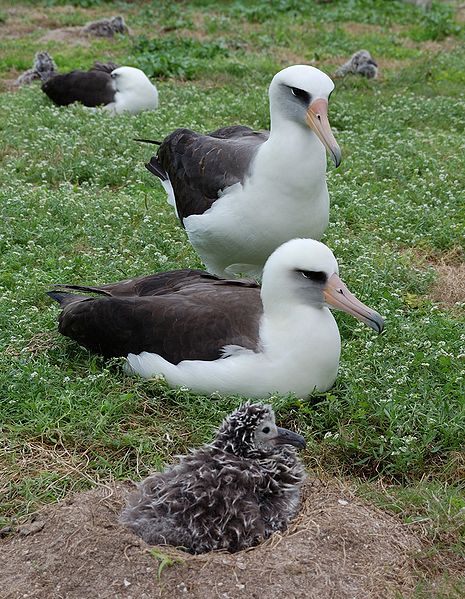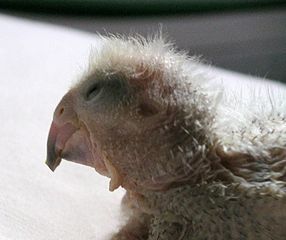 Parrots are reputed to live to great ages – over 100 years if some reports are to be believed. Less well-known are the incredible longevities racked up by some very small pet and wild birds. I’ve kept a casual tally of the ages attained by many of the species I cared for at the Bronx Zoo, and recently reviewed some published studies on this subject.
Parrots are reputed to live to great ages – over 100 years if some reports are to be believed. Less well-known are the incredible longevities racked up by some very small pet and wild birds. I’ve kept a casual tally of the ages attained by many of the species I cared for at the Bronx Zoo, and recently reviewed some published studies on this subject.
100-Year-Old Parrots?
A recent review of zoo collections, published in the International Zoo Yearbook (please see below), did not uncover any 100 year-old parrots. The most celebrated parrot in this category, a macaw named Charlie, is reputed to be 104 years old. Said to have been owned by Winston Churchill, Charlie now lives in Surrey, England, where he passes his time by screaming anti-Nazi sentiments. Unfortunately his history, and connection to his renowned former owner, could not be traced.
Among parrots known to live to ripe old ages, such as Amazons and Macaws, 50 years or so was found to be the maximum longevity, although several individuals reached ages of 65-70. Cockatoos of several species lived longer than most of their relatives, and reproduced well into old age. Larger parrots tended to have greater life-spans than smaller species, but there were some notable exceptions.
Parrots and other Pet Birds
Following are a few of the more impressive published longevities for parrots and others kept as pets. Please write in for information concerning these species in the wild.
African Grey parrot- 73 years
Green-Winged Macaw – 64 years
Blue and Gold Macaw – 43 years
Military Macaw – 30 Years
Canary – 24 years
Pekin Robin (please see article below) – 15 years
As one might expect, Rock Doves (Common Pigeons) are hardy souls. One captive reached age 35.
Zoo Birds
I’ve had the good fortune of working with several remarkable old birds, including a Maribou Stork (please see article below) and a Milky Eagle Owl. Each approached, or perhaps exceeded, 60 years of age. I was also very surprised to find that several Sandpipers and other tiny birds under my care had been in the collection for 25-30 years. Flamingoes, despite their “fragile” appearances, often lived into their 20’s, and occasionally reached 30+ years of age.
Other groups of birds that do well in zoos and regularly live into their 40’s include storks, herons, cranes, eagles and owls; both Brown and White Pelicans have topped 50 years of age. Hummingbirds, which might be expected to “burn out” early, typically live for 4-6 years. However, individuals belonging to at least 2 species have reached 12 years of age.
Wild Birds
Tagged wild birds have provided ornithologists with many surprises. Two in particular, both oceanic species that undertake epic migrations, are especially impressive.
 Recently a Laysan Albatross (please see photo) was identified as the oldest known free-living bird. First tagged by biologists in 1956, this Albatross and her chick survived a direct hit by a large wave generated by the devastating March, 2011 tsunami in Japan (the bird was nesting on Midway Island). She is over 60 years old and still breeding, and in her travels has logged approximately 3 million miles – or 6 trips to the moon!
Recently a Laysan Albatross (please see photo) was identified as the oldest known free-living bird. First tagged by biologists in 1956, this Albatross and her chick survived a direct hit by a large wave generated by the devastating March, 2011 tsunami in Japan (the bird was nesting on Midway Island). She is over 60 years old and still breeding, and in her travels has logged approximately 3 million miles – or 6 trips to the moon!
Just as impressive is a Manx Shearwater (a small seabird) that was tagged 52 years ago and has travelled an estimated 5 million miles – which would have taken her around the world 200 times!
Information Needed
Unfortunately, we do not have an accurate way to track the ages of most of the birds living in zoos and private collections.
Further Reading
Jake the Maribou Stork, the Bronx Zoo’s Oldest Animal
Laysan Pair with chick image referenced from wikipedia and originally posted by James Lloyd Original uploader was Jlfutari
Macaw image referenced from wikipedia and originally posted by Arjan Haverkamp
 That Bird Blog – Bird Care and History for Pet Birds
That Bird Blog – Bird Care and History for Pet Birds




Sadly it looks like Charlie is a fiction. We’ve tried tracking down information about Charlie with little success. Winston Churchill may have had a parrot, but more than likely it didn’t outlive him.
Hello, Frank Indiviglio here.
Thanks for the feedback; yes, I’m finding the same..too bad but plenty of interesting stories around. Thanks for your interest and the fine Tweets and re-tweetss
Good luck, enjoy and please keep me posted.
Best regards, Frank Indiviglio.
Thanks for writing such interesting articles.
Hello Melissa, Frank Indiviglio here.
Thanks for your interest and kind words. Please continue to check in…I look forward to your comments and questions.
Good luck, enjoy and please keep me posted.
Best regards, Frank Indiviglio
Hallo Frank
These figures are quite something!I knew African Grays get old but seeing the figures black on white brings following question to mind: How difficult is it for parrots (African Grey in this matter) to acclimatize to new owners when the first owner would be outlived? I can not recall reading information on previous Blogs.
The other amazing facts are that of the distances of the albatrosses…!!! I have read some where that they sometimes not eve touch ground for weeks in a row!
Best Regards and thanxzzz for these stunning facts!
Hello Gert, Frank Indiviglio here.
Thanks…always so good to hear that you are enjoying the articles. Parrots do indeed often have a hard time adjusting to new owners; people sometimes provide for them in their wills and so on. Age aside, they are very complicated, and can be very difficult if all is not perfect in captivity. Mate selection in the wild is a drawn out affair as well, with most species keeping the same mate for life.
Albatross may even “sleep” on the wing – automatic pilot type mechanism!
Please let me know if you need any further information. Good luck, enjoy and please keep me posted.
Best regards, Frank Indiviglio.
Regarding African Greys being able to adjust to new owners after many years with another.
My parents brought a wild caught Congo Grey into the USA from Africa in 1963. They gave him to my grandmother. She named him Junior. He talked a lot but wasn’t particularly tame.
When my grandmother entered a nursing home in 1982 the bird was given to me.
I was able to slowly turn him into one of the sweetest and most gentle parrots I have every had. ( I have 6 parrots, everything from a cockateil to a Blue and gold macaw)
Anyway Junior did adjust to the new situation, albeit, it took awhile, and eventually he kinda became the “King of the family flock”
Junior passed away at the ripe old age of 47, and is sadly missed.
Stan
Hello Stan,
Thanks for the very interesting story…sounds like parrot-keeping runs in the family! A is a good example for others…it takes time, effort and a long term commitment to be a responsible parrot owner.
Please let me know if you need any further information. Good luck, enjoy and please keep me posted.
Best regards, Frank Indiviglio.